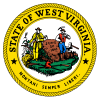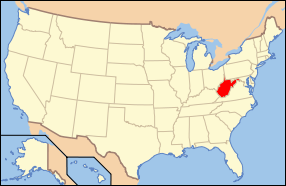West Virginia
| State of West Virginia | |||||||||||
|
|||||||||||
| Official language(s) | none (de facto English) | ||||||||||
| Demonym | West Virginian | ||||||||||
| Capital | Charleston | ||||||||||
| Largest city | Charleston | ||||||||||
| Largest metro area | Charleston metro area | ||||||||||
| Area | Ranked 41st in the US | ||||||||||
| - Total | 24,230 sq mi (62,755 km²) |
||||||||||
| - Width | 130 miles (210 km) | ||||||||||
| - Length | 240 miles (385 km) | ||||||||||
| - % water | 0.6 | ||||||||||
| - Latitude | 37° 12′ N to 40° 39′ N | ||||||||||
| - Longitude | 77° 43′ W to 82° 39′ W | ||||||||||
| Population | Ranked 37th in the US | ||||||||||
| - Total | 1,812,035 (2007 est.)[1] | ||||||||||
| - Density | 75.1/sq mi (29.0/km²) Ranked 27th in the US |
||||||||||
| - Median income | $38,029 (48th) | ||||||||||
| Elevation | |||||||||||
| - Highest point | Spruce Knob[2] 4,863 ft (1,427 m) |
||||||||||
| - Mean | 1,500 ft (460 m) | ||||||||||
| - Lowest point | Harpers Ferry[2] 240 ft (73 m) |
||||||||||
| Admission to Union | June 20, 1863 (35) | ||||||||||
| Governor | Joe Manchin (D) | ||||||||||
| Lieutenant Governor | Earl Ray Tomblin[3] | ||||||||||
| U.S. Senators | Robert C. Byrd (D) Jay Rockefeller (D) |
||||||||||
| Congressional Delegation | List | ||||||||||
| Time zone | Eastern: UTC-5/-4 | ||||||||||
| Abbreviations | WV US-WV | ||||||||||
| Website | wv.gov | ||||||||||
West Virginia (/ˌwɛstvɚˈdʒɪnjə/) is a state in the Appalachian, Upland South, and Mid-Atlantic regions of the United States, bordered by Virginia on the southeast, Kentucky on the southwest, Ohio on the northwest, and Pennsylvania and Maryland on the northeast. The capital and largest city is Charleston.
Historically the area now occupied by West Virginia was contested territory, mainly by Pennsylvania and Virginia. This rivalry resulted in some settlers petitioning the Continental Congress to create a new territory called Westsylvania. Some speculative land companies, such as the Vandalia Company[4], and later the Ohio Company and Indiana Company tried to legitimize their claims to land in parts of West Virginia and Kentucky but failed. With the settlement of the Pennsylvania and Virginia border dispute, which resulted in the creation of Kentucky, Kentuckians "were satisfied...and the inhabitants of a large part of West Virginia were grateful."[5]
After the Wheeling Conventions, West Virginia broke away from Virginia during the American Civil War and was admitted to the Union as a separate state on June 20, 1863, and was a key Civil War "border state." It is one of only two states formed during the American Civil War (along with Nevada, which separated from Utah Territory) and is the only state to form by seceding from a Confederate state and one of three states to secede from another state (the others being Kentucky and Maine).
The Census Bureau considers West Virginia part of the South because most of the state is south of the Mason-Dixon Line. The northern panhandle, however, extends adjacent to Pennsylvania and Ohio with the West Virginia city of Weirton on a parallel with Pittsburgh, while Bluefield is less than seventy miles from North Carolina and Harper's Ferry is considered to be a part of the Washington D.C. metropolitan area. The unique position of West Virginia means that it is often included in a wide variety of geographical regions, including the Southeastern United States and even the Northeastern United States. Notably, it is the only state which entirely lies within the area served by the Appalachian Regional Commission, which is a common definition of "Appalachia".[6]
The state is noted for its great natural beauty, its historically significant logging and coal mining industries, and its labor history. It is also known for a wide range of outdoor recreational opportunities, including skiing, whitewater rafting, rock climbing, caving, fishing, hiking, mountain biking, and hunting.
Contents |
Geography

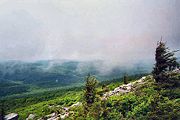
- See also: List of counties in West Virginia and List of West Virginia county seats
West Virginia is bordered by Pennsylvania to the north; by Ohio to the north and west; by Kentucky to the west; by Maryland to the north and east; and by Virginia to the east and south. The Ohio and Potomac rivers form parts of the boundaries.
West Virginia is the only state in the nation located entirely within the Appalachian Mountain range, and in which all areas are mountainous; for this reason it is nicknamed The Mountain State and also is partially the reason why its motto is "mountaineers are always free." About 75% of the state is within the Cumberland Plateau and Allegheny Plateau regions. Though the relief is not high, the plateau region is extremely rugged in most areas. The average elevation of West Virginia is approximately 1,500 feet above sea level-the highest of any US state east of the Mississippi River.
On the eastern state line with Virginia, high peaks in the Monongahela National Forest region give rise to an island of colder climate and ecosystems similar to those of northern New England and eastern Canada. The highest point in the state is atop Spruce Knob, at 4,863 ft (1,482 m),[2] is covered in a boreal forest of dense spruce trees at altitudes above 4,000 feet (1,220 m). Spruce Knob lies within the Monongahela National Forest and is a part of the Spruce Knob-Seneca Rocks National Recreation Area. [2] A total of six wilderness areas can also be found within the forest. Outside the forest to the south, the New River Gorge is a 1,000-foot (304 m) deep canyon carved by the New River. The National Park Service manages a portion of the gorge and river that has been designated as the New River Gorge National River, one of only 15 rivers in the U.S. with this level of protection.
Other areas under protection and management include:
|
|

The native vegetation for most of the state was originally mixed hardwood forest of oak, chestnut, maple, beech, and white pine, with willow and American sycamore along the state's waterways. Many of the areas are rich in biodiversity and scenic beauty, a fact that is appreciated by native West Virginians, who refer to their home as Almost Heaven. Ecologically, most of West Virginia falls into the Appalachian mixed mesophytic forests ecoregion.
The underlying rock strata are sandstone, shale, bituminous coal beds, and limestone laid down in a near shore environment from sediments derived from mountains to the east, in a shallow inland sea on the west. Some beds illustrate a coastal swamp environment, some river delta, some shallow water. Sea level rose and fell many times during the Mississippian and Pennsylvanian eras, giving a variety of rock strata. The Appalachian Mountains are some of the oldest on earth, having formed over 300 million years ago.
Climate
- Further information: Climate change in West Virginia
The climate of West Virginia borders on a humid subtropical climate (Koppen climate classification Cfa) in the lower elevations of the southwestern portion of the state (including Huntington and Charleston), along with parts of the Eastern Panhandle east of the Appalachians with hot, humid summers and milder winters. The rest of the state has a humid continental climate (Koppen climate classification Dfa, except Dfb at the higher elevations) with warm to hot, humid summers and cold winters, increasing in severity with elevation. However, the weather is subject in all parts of the state to change. The hardiness zones range from zone 5b in the central Appalachian mountains to zone 7a in the warmest parts of the lowest elevations. In the Eastern Panhandle and the Ohio River Valley temperatures are warm enough to see and grow subtropical plants such as Southern magnolia (Magnolia grandiflora), Crepe Myrtle, Albizia julibrissin, American Sweetgum and even the occasional needle palm and sabal minor. These plants don't thrive as well in other parts of the state.
Average January temperatures range from around 28°F (-2°C) near the Cheat River to 43°F (5°C) along sections of the border with Kentucky. July averages range from 67°F (19°C) along the North Branch Potomac River to 76°F (24°C) in the western part of the state. It is cooler in the mountains than in the lower sections of the state.
Annual precipitation ranges from less than 32 inches (810 mm) in the lower eastern section to more than 56 inches (1,400 mm) in higher parts of the Allegheny Front. Slightly more than half the rainfall occurs from April to September. Dense fogs are common in many valleys of the Kanawha section, especially the Tygart Valley. West Virginia is also one of the cloudiest states in the nation, with the cities of Elkins and Beckley ranking 9th. and 10th. in the U.S. respectively for the number of cloudy days per year (over 210). In addition to persistent cloudy skies caused by the damming of moisture by the Alleghenies, West Virginia also experiences some of the most frequent precipitation in the nation, with Snowshoe averaging nearly 200 days a year with either rain or snow. Snow usually lasts only a few days in the lower sections but may persist for weeks in the higher mountain areas. An average of 34 inches (86 cm) of snow falls annually in Charleston, although during the winter of 1995–1996 more than three times that amount fell as several cities in the state established new records for snowfall. Average snowfall in the Allegheny Highlands can range up to 180 inches per year.
| Monthly normal high and low temperatures for various West Virginia cities | ||||||||||||
| City | Jan | Feb | Mar | Apr | May | Jun | Jul | Aug | Sep | Oct | Nov | Dec |
|---|---|---|---|---|---|---|---|---|---|---|---|---|
| Beckley | 39/22 | 43/25 | 52/32 | 62/41 | 71/49 | 77/57 | 80/61 | 79/60 | 73/54 | 63/42 | 52/34 | 43/26 |
| Charleston | 43/24 | 47/27 | 57/34 | 67/42 | 75/50 | 82/58 | 85/63 | 84/62 | 77/55 | 67/43 | 56/35 | 47/28 |
| Elkins | 39/18 | 44/20 | 53/27 | 63/35 | 72/44 | 78/53 | 82/58 | 80/57 | 74/50 | 64/37 | 53/29 | 44/22 |
| Huntington | 41/24 | 46/28 | 56/36 | 67/44 | 75/53 | 82/61 | 85/65 | 84/64 | 77/57 | 66/45 | 55/37 | 45/29 |
| [3] | ||||||||||||
Prehistoric
-
For more details on this topic, see West Virginia Prehistory.
In summary to quote Dr. Robert F. Maslowski, "The Adena Indians used pipes for ceremonies. They were carved of stone and they were exceptional works of art. Pipes and the smoking of tobacco became more common during the Late Prehistoric period. They were often made of clay and rather plain." "Nothing is known about Paleo-Indian and Archaic houses in the Kanawha Valley, but archeologists have found evidence of Woodland and Fort Ancient houses." "Woodland Indians lived in wigwams...The Woodland Indians grew sunflowers, gourds, squash and several seeds such as lambsquarter, may grass, sumpweed, smartweed and little barley." "Fort Ancient Indians lived in much larger square or rectangular houses...The Fort Ancient Indians can be considered true farmers. They cultivated large agricultural fields around their villages. They no longer grew such a variety of seeds but concentrated on growing corn, beans, sunflowers, gourds and many types of squash including the pumpkin. They also grew domestic turkeys and kept dogs as pets."
History
West Virginia's unique geography allowed for exploration from two concurrent directions and a duality of a "Border State".
European exploration and settlement
- Further information: Vandalia (colony) and Westsylvania
In 1671, General Abram Wood, at the direction of Royal Governor William Berkeley of the Virginia Colony, sent a party which discovered Kanawha Falls. In 1716, Governor Alexander Spotswood with about thirty horsemen made an excursion into what is now Pendleton County. John Van Metre, an Indian trader, penetrated into the northern portion in 1725. The same year, German settlers from Pennsylvania founded New Mecklenburg, the present Shepherdstown, on the Potomac River, and others followed.
King Charles II of England, in 1661, granted to a company of gentlemen the land between the Potomac and Rappahannock rivers, known as the Northern Neck. The grant finally came into the possession of Thomas Fairfax, 6th Lord Fairfax of Cameron, and in 1746, a stone was erected at the source of the North Branch Potomac River to mark the western limit of the grant. A considerable part of this land was surveyed by George Washington between 1748 and 1751. The diary kept by the surveyor indicates that there were already many squatters, largely of German origin, along the South Branch Potomac River. Christopher Gist, a surveyor in the employ of the first Ohio Company, which was composed chiefly of Virginians, explored the country along the Ohio River north of the mouth of the Kanawha River between 1751 and 1752. The company sought to have a fourteenth colony established with the name "Vandalia". Many settlers crossed the mountains after 1750, though they were hindered by Native American resistance. Few Native Americans lived permanently within the present limits of the state, but the region was a common hunting ground, crossed by many trails. During the French and Indian War the scattered British settlements were almost destroyed.
In 1774, the Crown Governor of Virginia John Murray, 4th Earl of Dunmore, led a force over the mountains, and a body of militia under then-Colonel Andrew Lewis dealt the Shawnee Indians, under Hokoleskwa (or "Cornstalk"), a crushing blow during the Battle of Point Pleasant at the junction of the Kanawha and the Ohio rivers. Native American attacks continued until after the American Revolutionary War. During the war, the settlers in western Virginia were generally active Whigs and many served in the Continental Army, however Claypool's Rebellion of 1780–1781 where a group of men refused to pay Colonial taxes showed war-weariness in West Virginia.
Trans-Allegheny Virginia, 1776-1861
-
For more details on this topic, see Virginia.
Social conditions in western Virginia were entirely unlike those in the eastern portion of the state. The population was not homogeneous, as a considerable part of the immigration came by way of Pennsylvania and included Germans, Protestant Ulster-Scots, and settlers from the states farther north. Counties in the east and south were settled mostly by east Virginians. During the American Revolution, the movement to create a state beyond the Alleghanies was revived and a petition for the establishment of "Westsylvania" was presented to Congress, on the grounds that the mountains made an almost impassable barrier on the east. The rugged nature of the country made slavery unprofitable, and time only increased the social, political, economic and cultural differences (see Tuckahoe-Cohee) between the two sections of Virginia.
The convention that met in 1829 to form a new constitution for Virginia, against the protest of the counties beyond the mountains, required a property qualification for suffrage and gave the slave-holding counties the benefit of three-fifths of their slave population in apportioning the state's representation in the U.S. House of Representatives. As a result, every county beyond the Alleghenies except one voted to reject the constitution, which nevertheless passed because of eastern support.
The Virginia Constitutional Convention of 1850-51, the Reform Convention, addressed a number of issues important to western Virginians. The vote was extended to all white males of 21 years of age plus. The governor, lieutenant-governor, the judiciary, sheriffs and other county officers were to be elected by public vote. The composition of the General Assembly was changed, representation in the house of delegates was apportioned on the white basis of the census of 1850, but the Senate was fixed arbitrarily, the west receiving twenty, and the east thirty, senators. This was made acceptable to the west by a provision that required the General Assembly to reapportion representation on the white basis in 1865, or else put the matter to a public referendum. But the east also gave itself a tax advantage in requiring a property tax at true and actual value, except for slaves. Slaves under the age of 12 years were not taxed, and slaves over that age were taxed at only $300, a fraction of their true value. Small farmers, however, had all their assets, animals and land, taxed at full value. Despite this tax and the lack of internal improvements in the west, the vote was 75,748 for and 11,063 against the new Constitution, most of the latter being from eastern counties, which did not like the compromises made for the west.[7]
Separation from Virginia
- See also: West Virginia in the American Civil War
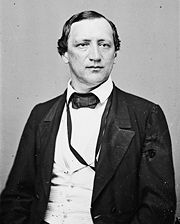
West Virginia is the only state in the Union to secede from a Confederate state, Virginia, during the American Civil War.[8] On April 17, 1861 fifteen of the forty-six delegates from the area located in the present state of West Virginia voted to secede from the United States.[9] Almost immediately after the vote to proceed with secession prevailed in the Virginia General Assembly, a mass meeting at Clarksburg recommended that each county in northwestern Virginia send delegates to a convention to meet in Wheeling on May 13, 1861. When this First Wheeling Convention met, 425 delegates from 25 counties were present, though more than one-third of the delegates were from the northern panhandle area,[10] but soon there was a division of sentiment. Some delegates favored the immediate formation of a new state, while others argued that, as Virginia's secession had not yet been passed by the required referendum, such action would constitute revolution against the United States.[11] It was decided that if the ordinance were adopted (of which there was little doubt), another convention including the members-elect of the legislature should meet at Wheeling in June. At the election on May 23, 1861, secession was ratified by a large majority in the state as a whole, but in the western counties 34,677 voted against and 19,121 voted for the Ordinance.[12]
The Second Wheeling Convention met as agreed on June 11 and declared that, since the Secession Convention had been called without the consent of the people, all its acts were void, and that all who adhered to it had vacated their offices. The Wheeling Conventions, and the delegates themselves, were never actually elected by public ballot to act on behalf of western Virginia.[13] An act for the reorganization of the government was passed on June 19. The next day Francis H. Pierpont was chosen by other delegates at the convention to be governor of Virginia, other officers were elected and the convention adjourned. The legislature was composed of 103 members, 33 of whom had been elected to the Virginia General Assembly[14] on May 23. This number included some hold-over Senators from 1859, and as such had vacated their offices to convene in Wheeling. The other members "were chosen even more irregularly-some in mass meetings, others by county committee, and still others were seemingly self-appointed"[15] This irregular assembly met on June 20 and appointed Unionists to the hold the remainder of the state offices, organized a rival state government and elected two United States senators who were promptly recognized by the Federal government in Washington, D.C. Thus, there were two state governments in Virginia, one pledging allegiance to the United States and one to the Confederacy.
The Wheeling Convention, which had taken a recess until August 6, reassembled on August 20, and called for a popular vote on the formation of a new state and for a convention to frame a constitution if the vote should be favorable. At the October 24, 1861 election, 18,489 votes were cast for the new state and only 781 against. The honesty of these election results have been questioned, since the Union army then occupied the area and Union troops were stationed at many of the polls to prevent Confederate sympathizers from voting.[16] Most of the affirmative votes came from ten counties in the Wheeling area.[17] Over 50,000 votes had been cast on the Ordinance of Secession, yet the vote on statehood gathered little more than 19,000. In Ohio County, home to Wheeling, only about one-quarter of the registered voters cast votes.[18] At the Constitutional Convention in November 1861, Mr. Lamb of Ohio County and Mr. Carskadon said that in Hampshire County, out of 195 votes only 39 were cast by citizens of the state; the rest were cast illegally by Union soldiers.[19] In most of what would become West Virginia, there was no vote at all as two-thirds of the territory of West Virginia had voted for secession and county officers were still loyal to Richmond.[20] Votes recorded from pro-secession counties were mostly cast elsewhere by Unionist refugees from these counties.[21] The convention began on November 26, 1861, and finished its work on February 18, 1862; the instrument was ratified (18,162 for and 514 against) on April 11, 1862.

On May 13, the state legislature of the reorganized government approved the formation of the new state. An application for admission to the Union was made to Congress, and on December 31, 1862, an enabling act was approved by President Abraham Lincoln admitting West Virginia, on the condition that a provision for the gradual abolition of slavery be inserted in its Constitution. Many, including Lincoln, felt that West Virginia's admission as a state was both illegal and unconstitutional, but wartime politics prevailed.[22] The Convention was reconvened on February 12, 1863, and the demand was met. The revised constitution was adopted on March 26, 1863, and on April 20, 1863, President Lincoln issued a proclamation admitting the state at the end of sixty days (June 20, 1863). Meanwhile, officers for the new state were chosen and Governor Pierpont moved his capital to Union-occupied Alexandria, where he asserted jurisdiction over all of the Virgina counties within the Federal lines.
The question of the constitutionality of the formation of the new state was brought before the Supreme Court of the United States in the following manner: Berkeley and Jefferson counties lying on the Potomac east of the mountains, in 1863, with the consent of the reorganized government of Virginia voted in favor of annexation to West Virginia. Many voters of the strongly pro-secessionist counties were absent in the Confederate Army when the vote was taken and refused to acknowledge the transfer upon their return. The Virginia General Assembly repealed the act of secession and in 1866 brought suit against West Virginia, asking the court to declare the counties a part of Virginia which would have declared West Virginia's admission as a state unconstitutional. Meanwhile, on March 10, 1866, Congress passed a joint resolution recognizing the transfer. The Supreme Court, in 1870, decided in favor of West Virginia.[23]
During the American Civil War, West Virginia suffered comparatively little. George B. McClellan's forces gained possession of the greater part of the territory in the summer of 1861, culminating at the Battle of Rich Mountain, and Union control was never again seriously threatened, despite of the attempt by Robert E. Lee in the same year. In 1863, General John D. Imboden, with 5,000 Confederates, overran a considerable portion of the state. Bands of guerrillas burned and plundered in some sections, and were not entirely suppressed until after the war ended.
The area which became West Virginia actually furnished about an equal number of soldiers to the Federal and Confederate armies[4], approximately 22,000-25,000 each. The Wheeling government found it necessary in 1865 to strip voting rights from returning Confederates in order to retain control. James Ferguson, who proposed the law, said that if it was not enacted he would lose election by 500 votes.[24] The property of Confederates might also be confiscated, and in 1866 a constitutional amendment disfranchising all who had given aid and comfort to the Confederacy was adopted. The addition of the Fourteenth and Fifteenth Amendments to the United States Constitution caused a reaction. The Democratic party secured control in 1870, and in 1871, the constitutional amendment of 1866 was abrogated. The first steps toward this change had been taken, however, by the Republicans in 1870. On August 22, 1872, an entirely new constitution was adopted.
Beginning in Reconstruction, and for several decades thereafter, the two states disputed the new state's share of the pre-war Virginia government's debts, which had mostly been incurred to finance public infrastructure improvements, such as canals, roads, and railroads under the Virginia Board of Public Works. Virginians, led by former Confederate General William Mahone, formed a political coalition which was based upon this, the Readjuster Party. Although West Virginia's first constitution provided for the assumption of a part of the Virginia debt, negotiations opened by Virginia in 1870 were fruitless, and in 1871, Virginia funded two-thirds of the debt and arbitrarily assigned the remainder to West Virginia. The issue was finally settled in 1915, when the Supreme Court of the United States ruled that West Virginia owed Virginia $12,393,929.50. The final installment of this sum was paid in 1939.
Hidden resources
After Reconstruction, the new 35th state benefited from development of its mineral resources more than any other single economic activity.
Salt mining had been underway since the 18th century, though it had largely played out by the time of the American Civil War, when the red salt of Kanawha County was a valued commodity of first Confederate, and later Union forces. Later, more sophisticated mining methods would restore West Virginia's role as a major producer of salt.
However, in the second half of the 19th century, there was an even greater treasure not yet developed, bituminous coal. It would fuel much of the Industrial Revolution in the U.S. and the steamships of many of the world's navies.
The residents (both Native Americans and early European settlers) had long known of the underlying coal, and that it could be used for heating and fuel. However, for a long time, very small "personal" mines were the only practical development. After the War, with the new railroads came a practical method to transport large quantities of coal to expanding U.S. and export markets. As the anthracite mines of northwestern New Jersey and Pennsylvania began to play out during this same time period, investors and industrialists focused new interest in West Virginia. Geologists such as Dr. David T. Ansted surveyed potential coal fields and invested in land and early mining projects.
The completion of the Chesapeake and Ohio Railway (C&O) across the state to the new city of Huntington on the Ohio River in 1872 opened access to the New River Coal Field. Soon, the C&O was building its huge coal pier at Newport News, Virginia on the large harbor of Hampton Roads. In 1881, the new Philadelphia-based owners of the former Atlantic, Mississippi and Ohio Railroad (AM&O), which stretched across Virginia's southern tier from Norfolk, had sights clearly set on the Mountain State, where the owners had large land holdings. Their railroad was renamed Norfolk and Western (N&W), and a new railroad city was developed at Roanoke to handle planned expansion. After its new president Frederick J. Kimball and a small party journeyed by horseback and saw firsthand the rich bituminous coal seam which his wife named "Pocahontas", the N&W redirected its planned westward expansion to reach it. Soon, the N&W was also shipping from new coal piers at Hampton Roads.
In 1889, in the southern part of the state, along the Norfolk and Western rail lines, the important coal center of Bluefield, West Virginia was founded. The "capital" of the Pocahontas coalfield, this city would remain the largest city in the southern portion of the state for several decades. It shares a sister city with the same name, Bluefield, in Virginia.
In the northern portion of the state and elsewhere, the older Baltimore and Ohio Railroad (B&O) and other lines also expanded to take advantage of coal opportunities. The B&O developed coal piers in Baltimore and at several points on the Great Lakes. Other significant rail carriers of coal were the Western Maryland Railway (WM), Southern Railway (SOU), and the Louisville and Nashville Railroad (L&N).
Particularly notable was a latecomer, the Virginian Railway (VGN). By 1900, only a large area of the most rugged terrain of southern West Virginia was any distance from the existing railroads and mining activity. Within this area west of the New River Coalfield in Raleigh and Wyoming counties lay the Winding Gulf Coalfield, later promoted as the "Billion Dollar Coalfield."
A protégé of Dr. Ansted was William Nelson Page (1854–1932), a civil engineer and mining manager in Fayette County. Former West Virginia Governor William A. MacCorkle described him as a man who knew the land "as a farmer knows a field." Beginning in 1898, Page teamed with northern and European-based investors to take advantage of the undeveloped area. They acquired large tracts of land in the area, and Page began the Deepwater Railway, a short-line railroad which was chartered to stretch between the C&O at its line along the Kanawha River and the N&W at Matoaka, a distance of about 80 miles.
Although the Deepwater plan should have provided a competitive shipping market via either railroad, leaders of the two large railroads did not appreciate the scheme. In secret collusion, each declined to negotiate favorable rates with Page, nor did they offer to purchase his railroad, as they had many other short-lines. However, if the C&O and N&W presidents thought they could thus kill the Page project, they were to be proved mistaken. One of the silent partner investors Page had enlisted was millionaire industrialist Henry Huttleston Rogers, a principal in John D. Rockefeller's Standard Oil Trust and an old hand at developing natural resources, transportation. A master at competitive "warfare", Henry Rogers did not like to lose in his endeavors, and also had "deep pockets".
Instead of giving up, Page (and Rogers) quietly planned and then built their tracks all the way east across Virginia, using Rogers' private fortune to finance the $40 million cost. When the renamed Virginian Railway (VGN) was completed in 1909, no less than three railroads were shipping ever-increasing volumes of coal to export from Hampton Roads. West Virginia coal was also under high demand at Great Lakes ports. The VGN and the N&W ultimately became parts of the modern Norfolk Southern system, and the VGN's well-engineered 21th century tracks continue to offer a favorable gradient to Hampton Roads.
As coal mining and related work became major employment activities in the state, there was considerable labor strife as working conditions, safety issues, and economic concerns arose. Even in the 21st century, mining safety and ecological concerns is still challenging to the state whose coal continues to power electrical generating plants in many other states.
Coal is not the only valuable mineral found in West Virginia, as the state was the site of the 1928 discovery of the 34.48 carat (6.896 g) Jones Diamond.
Demographics
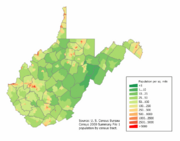
| Historical populations | |||
|---|---|---|---|
| Census | Pop. | %± | |
| 1790 | 55,873 |
|
|
| 1800 | 78,592 | 40.7% | |
| 1810 | 105,469 | 34.2% | |
| 1820 | 136,808 | 29.7% | |
| 1830 | 176,924 | 29.3% | |
| 1840 | 224,537 | 26.9% | |
| 1850 | 302,313 | 34.6% | |
| 1860 | 376,688 | 24.6% | |
| 1870 | 442,014 | 17.3% | |
| 1880 | 618,457 | 39.9% | |
| 1890 | 762,794 | 23.3% | |
| 1900 | 958,800 | 25.7% | |
| 1910 | 1,221,119 | 27.4% | |
| 1920 | 1,463,701 | 19.9% | |
| 1930 | 1,729,205 | 18.1% | |
| 1940 | 1,901,974 | 10% | |
| 1950 | 2,005,552 | 5.4% | |
| 1960 | 1,860,421 | −7.2% | |
| 1970 | 1,744,237 | −6.2% | |
| 1980 | 1,949,644 | 11.8% | |
| 1990 | 1,793,477 | −8% | |
| 2000 | 1,808,344 | 0.8% | |
The center of population of West Virginia is located in Braxton County, in the town of Gassaway.[25]
As of 2005, West Virginia has an estimated population of 1,816,856, which is an increase of 4,308, or 0.2%, from the prior year and an increase of 8,506, or 0.5%, since the year 2000. This includes a natural decrease since the last census of 3,296 people (that is 108,292 births minus 111,588 deaths) and an increase from net migration of 14,209 people into the state. Immigration from outside the United States resulted in a net increase of 3,691 people, and migration within the country produced a net increase of 10,518 people.
Only 1.1% of the state's residents were foreign-born, placing West Virginia last among the 50 states in that statistic. It has the lowest percentage of residents that speak a language other than English in the home (2.7%).
The five largest ancestry groups in West Virginia are: American (23.2%), German (17.2%), Irish (13.5%), English (12%), Italian (4.8%).
Large numbers of people of German ancestry are present in the northeastern counties of the state.
5.6% of West Virginia's population were reported as under 5, 22.3% under 18, and 15.3% were 65 or older. Females made up approximately 51.4% of the population.
There were 20,928 births in 2006. Of these, 19,757 (94.40% of the births, 95.19% of the population) were to Non-Hispanic Whites. There were 22 births to American Indians (0.11% of the births and 0.54% of the population), 177 births to Asians (0.85% of the births and 0.68% of the population), 219 births to Hispanics (1.05% of the births and 0.88% of the population) and 753 births to Blacks and others (3.60% of the births and 3.56% of the population). [5]
The state's Northern Panhandle, and North-Central region feel an affinity for Pittsburgh, Pennsylvania. Also, those in the Eastern Panhandle feel a connection with the Washington, D.C. suburbs in Maryland and Virginia, and southern West Virginians often consider themselves Southerners. Finally, the towns and farms along the mid-Ohio River have an appearance and culture somewhat resembling the Midwest.[26]
| Demographics of West Virginia (csv) | |||||
|---|---|---|---|---|---|
| By race | White | Black | AIAN* | Asian | NHPI* |
| 2000 (total population) | 96.01% | 3.49% | 0.59% | 0.66% | 0.05% |
| 2000 (Hispanic only) | 0.63% | 0.04% | 0.02% | 0.01% | 0.01% |
| 2005 (total population) | 95.99% | 3.56% | 0.56% | 0.69% | 0.05% |
| 2005 (Hispanic only) | 0.80% | 0.04% | 0.02% | 0.01% | 0.01% |
| Growth 2000–05 (total population) | 0.46% | 2.49% | -3.96% | 5.57% | -2.80% |
| Growth 2000–05 (non-Hispanic only) | 0.28% | 2.30% | -4.24% | 5.96% | -0.52% |
| Growth 2000–05 (Hispanic only) | 27.74% | 21.51% | 5.56% | -20.22% | -16.67% |
| * AIAN is American Indian or Alaskan Native; NHPI is Native Hawaiian or Pacific Islander | |||||
Religion
Responses to a 2001 religious survey were:[27]
- Christian (75%)
- Protestant (60%)
- Non-denominational Christian (7%)
- Roman Catholic (8%)
- Not religious (13%)
- A non-Christian religion (4%)
- 6% refused to answer.
Economy
The economy of West Virginia is one of the most fragile of any U.S. state. According to U.S. Census Bureau data, West Virginia is the third lowest in per capita income,[28] ahead of only Arkansas and Mississippi. It also ranks last in median household income.[29] The proportion of West Virginia's adult population with a bachelor's degree is the lowest in the U.S. at 15.3%.[30]
West Virginia's GDP was $55.6B in 2006, which was a 0.6% increase from 2005. This makes growth rate for the state the 2nd lowest in the nation, behind only Michigan.
One of the major resources in West Virginia's economy is coal. According to the Energy Information Administration, West Virginia is a top coal-producer in the United States, second only to Wyoming. West Virginia produces minimal oil and natural gas. Nearly all of the electricity generated in West Virginia is from coal-fired power plants. West Virginia produces a surplus of electricity and leads the Nation in net interstate electricity exports.[31] Farming is also practiced in West Virginia, but on a limited basis because of the mountainous terrain over much of the state.
West Virginia personal income tax is based on federal adjusted gross income (not taxable income), as modified by specific items in West Virginia law. Citizens are taxed within 5 income brackets, which range from 3.0% to 6.5%. The state's consumer sales tax is levied at 6%. Effective January 1, 2004 calculation of WV consumer sales tax has been converted to a calculated figure from the bracket system, and remains at six percent for most goods (food goods are now taxable at three percent). The computation of tax is carried out to the third decimal place and rounded up when the third decimal place is five (.005) or higher; and similarly rounded down if the third place is four (.004) or lower. By virtue of this method, sales totaling $0.08 and below would not have a sales tax associated with them.[32]
West Virginia counties administer and collect property taxes, although property tax rates reflect levies for state government, county governments, county boards of education, and municipalities. Counties may also impose a hotel occupancy tax on lodging places not located within the city limits of any municipality that levies such a tax. Municipalities may levy license and gross receipts taxes on businesses located within the city limits and a hotel occupancy tax on lodging places in the city. Although the Department of Tax and Revenue plays a major role in the administration of this tax, less than one-half of one percent of the property tax collected goes to state government. The primary beneficiaries of the property tax are county boards of education. Property taxes are paid to the sheriff of each of the state's 55 counties. Each county and municipality can impose its own rates of property taxation within the limits set by the West Virginia Constitution. The West Virginia legislature sets the rate of tax of county boards of education. This rate is used by all county boards of education statewide. However, the total tax rate for county boards of education may differ from county to county because of excess levies. The Department of Tax and Revenue supervises and otherwise assists counties and municipalities in their work of assessment and tax rate determination. The total tax rate is a combination of the tax levies from four state taxing authorities: state, county, schools, and municipal. This total tax rate varies for each of the four classes of property, which consists of personal, real, and intangible properties. Property is assessed according to its use, location, and value as of July 1. All property is reappraised every three years; annual adjustments are made to assessments for property with a change of value. West Virginia does not impose an inheritance tax. Because of the phase-out of the federal estate tax credit, West Virginia's estate tax is not imposed on estates of persons who died in 2005.
Transportation
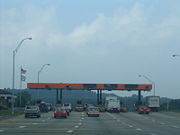

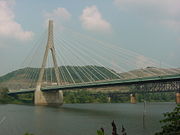
Highways form the backbone of transportation systems in West Virginia, with over 37,300 miles of public roads in the state.[33] Airports, railroads, and rivers complete the commercial transportation modes for West Virginia. Commercial air travel is facilitated by airports in Charleston, Huntington, Morgantown, Beckley, Bluefield, Lewisburg, Clarksburg, Martinsburg, Wheeling, and Parkersburg. Cities like Charleston, Huntington, Clarksburg, Fairmont, Bluefield, and Logan have bus-based public transit systems. Charleston also has a limited number of trolley cars that run primarily through the downtown area. West Virginia University in Morgantown boasts the PRT (personal rapid transit) system, the state's only single rail public transit system. Developed by Boeing, the WVU School of Engineering and the Department of Transportation, it was a model for low-capacity light transport designed for smaller cities. It was also the model for DisneyWorld's tram system. Recreational transportation opportunities abound in West Virginia, including hiking trails,[34] rail trails,[35] ATV off road trails,[36] white water rafting rivers,[37] and two tourist railroads (Cass Scenic Railroad,[38] and the Potomac Eagle Scenic Railroad).[39]
West Virginia is crossed by several interstate highways. I-64 enters the state near White Sulphur Springs in the mountainous east, and exits for Kentucky in the west, near Huntington. I-77 enters from Virginia in the south, near Bluefield. It runs north past Parkersburg before it crosses into Ohio. I-64 and I-77 are merged in a stretch of toll road known as the West Virginia Turnpike, on which construction began in 1952. It runs from just east of Charleston south to the exit for Princeton. I-68's western terminus is in Morgantown. From there it runs east into Maryland. At the I-68 terminus in Morgantown, it meets I-79, which enters from Pennsylvania and runs through the state to its southern terminus in Charleston. I-70 briefly runs through West Virginia, crossing the northern panhandle through Wheeling. I-81 also briefly runs in West Virginia through the Eastern Panhandle where it goes through Martinsburg.
An interstate quality road is currently being built that will eventually stretch from I-79 near Weston, WV to at least Wardensville, WV. The western stretch has been completed as far east as Elkins, WV but is incomplete from there to Moorefield, WV. It is not certain whether the highway will eventually continue east past Wardensville on up to the Virginia state line and ultimately connect to I-81 just south of Winchester, VA or not.
Rail lines in the state used to be more prevalent, but many lines have been discontinued because of increased automobile traffic. Many old tracks have been converted to rail trails for recreational use, and the state is still served by a few commercial lines for hauling coal and by Amtrak. In 2006 Norfolk Southern along with the West Virginia and U.S. Government approved a plan to modify many of the rail tunnels in West Virginia, espeically in the southern half of the state, to allow for double stacked cars (see intermodal freight). This is expected to also help bring economic growth to the southern half of the state.
Because of the mountainous nature of the entire state, West Virginia has several notable tunnels and bridges. The most famous of these is the New River Gorge Bridge, which was at a time the longest steel single-arch bridge in the world with a 3,031-foot (924 m) span. The bridge is also pictured on the West Virginia state quarter. The Veterans Memorial Bridge (Weirton-Steubenville Bridge) was at its time of construction one of only three cable-stayed steel girder trusses in the United States. It connects Steubenville, Ohio with Weirton, West Virginia along US Route 22.
In March 2008, The American State Litter Scorecard, presented at the American Society for Public Administration national conference, rated West Virginia as a nationally Worst state for removing litter/debris from highways and public properties. The state has an above average fatality rate from litter/debris-caused vehicle accidents [40]
Law and government
West Virginia's capital and seat of government is the city of Charleston, located in the southwest area of the state.
Legislative branch
- Further information: West Virginia Legislature
The West Virginia Legislature is bicameral, consisting of the House of Delegates and the Senate. It is a citizen's legislature, meaning that legislative office is not a full-time occupation, but rather a part-time position. Consequently, the legislators often hold a full-time job in their community of residence.
Typically, the legislature is in session for 60 days between January and early April. The final day of the regular session ends in a bewildering fury of last-minute legislation in order to meet a constitutionally imposed deadline of midnight. During the remainder of the year, monthly interim sessions are held in preparation for the regular session. Legislators also gather periodically for 'special' sessions when called by the governor.
Executive branch
- Further information: List of Governors of West Virginia
The governor, elected every four years on the same day as the U.S. Presidential election, is sworn in during the following January.
Governors of West Virginia can serve two consecutive terms but must sit out a term before serving a third term in office.
Judicial branch
- Further information: Supreme Court of Appeals of West Virginia
West Virginia is one of thirteen states that does not have a death penalty.
For the purpose of courts of general jurisdiction, the state is divided into 31 judicial circuits. Each circuit is made up of one or more counties. Circuit judges are elected in partisan elections to serve eight-year terms.
West Virginia’s highest court is the Supreme Court of Appeals. The Supreme Court of Appeals of West Virginia is the busiest appellate court of its type in the United States. West Virginia is one of 11 states with a single appellate court. The state constitution allows for the creation of an intermediate court of appeals, but the Legislature has never created one. The Supreme Court is made up of five justices, elected in partisan elections to 12-year terms.
West Virginia is an alcoholic beverage control state. However, unlike most such states, it does not operate retail outlets, having exited that business in 1990. It retains a monopoly on wholesaling of distilled spirits only.
Politics
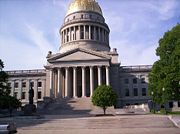
At the state level, West Virginia's politics are largely dominated by the Democratic Party, with Democrats currently holding the governorship, both senate seats, two of three house seats and both houses of the state legislature. West Virginia also has a very strong tradition of union membership. In the Republican landslide of 1988, it was one of only ten states, and the only southern state (as defined by the US Census), to give its electoral votes to Michael Dukakis; it was one of only six states to support Jimmy Carter over Ronald Reagan in 1980; and it supported Bill Clinton by large margins in both 1992 and 1996. However, the West Virginia State Democratic Party, like many State Democratic Parties in the South, is on the whole more conservative than the national party. For example, Senator Robert Byrd opposes affirmative action and gay marriage, while Governor Joe Manchin and Congressmen Alan Mollohan and Nick Rahall are pro-life on the issue of abortion. Furthermore, the state has trended increasingly Republican in Presidential elections; despite the earlier Democratic wins in Presidential matchups mentioned, it narrowly elected George W. Bush over Al Gore in 2000, then re-elected Bush by a much larger margin in 2004 and voted for John McCain in 2008 by a similar margin to 2004 despite Barack Obama winning by 6% nationwide.
The most consistent support for Democrats is found in the coal fields of southern West Virginia (especially McDowell, Mingo, Logan, Wyoming, and Boone Counties), while Republicans are most numerous to the east of the Allegheny Mountains, especially in the state's Eastern Panhandle and Potomac Highlands. The Northern Panhandle and North-Central West Virginia regions usually split right down the middle in terms of being Republican or Democrat.
Since 1996, coal interests have contributed more than $4 million to candidates for governor, the state Supreme Court and the West Virginia Legislature. The 2004 election was a record-setter for the coal industry. Gov. Joe Manchin received $571,214 from coal interests for his campaign and $174,500 for his inaugural.West Virginians for Coal, the West Virginia Coal Association's political action committee, contributed more money than any other coal industry donor.[41]
Important cities and towns
- See also: List of cities in West Virginia, List of towns in West Virginia, List of villages in West Virginia, List of census-designated places in West Virginia




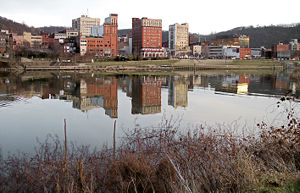
Large cities (> 10,000 population)
|
|
Towns and small cities
|
|
|
|
|
Metropolitan Statistical Areas
|
|
Micropolitan Statistical Areas
|
|
Education

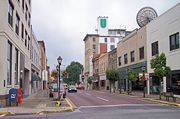
West Virginia has received low marks for reading and math skills at the eighth-grade level and ranked 51st in college education rates.[42]
Colleges and universities
- Further information: List of colleges and universities in West Virginia
|
|
Sports

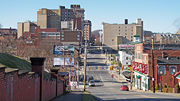
| Club | Sport | League |
|---|---|---|
| West Virginia Mountaineers | Football / Basketball | College Football / College Basketball |
| Marshall Thundering Herd | Football / Basketball | College Football / College Basketball |
| Bluefield Orioles | Baseball | Appalachian League |
| Princeton Rays | Baseball | Appalachian League |
| West Virginia Power | Baseball | South Atlantic League |
| Wheeling Nailers | Ice hockey | ECHL |
| West Virginia Wild | Basketball | International Basketball League |
| Huntington Heroes | Indoor football | American Indoor Football Association |
| West Virginia Crash | Football | United States Football Alliance |
| Ohio Valley Greyhounds | Indoor football | United Indoor Football |
| West Virginia Chaos | Soccer | USL Premier Development League |
Miscellaneous topics
| West Virginia state insignia | |
|---|---|
| Motto | Montani semper liberi (Latin, "Mountaineers are Always Free") |
| Slogan | "Wild and Wonderful" "Open for Business" (former) "Almost Heaven" (former) |
| Bird | Northern Cardinal (Cardinalis cardinalis) |
| Animal | Black Bear (Ursus americanus) |
| Fish | Brook Trout (Salvelinus fontinalis) |
| Insect | European Honey Bee (Apis mellifera) |
| Flower | Rhododendron (Rhododendron maximum) |
| Tree | Sugar Maple (Acer saccharum) |
| Song | "The West Virginia Hills" "This Is My West Virginia" "West Virginia, My Home Sweet Home" |
| Quarter | 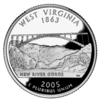 Released in 2005 |
| Butterfly | Monarch Butterfly (Danaus plexippus) |
| Reptile | Timber Rattlesnake (Crotalus horridus) |
| Wildflower | Fringed Gentian (Gentiana crinita) |
| Colors | Old Gold and Blue |
| Gemstone | Silicified Mississippian Fossil Coral (Lithostrotionella) |
| Soil | Monongahela Silt Loam |
| Fruit | Golden Delicious Apple (Malus domestica) |
The state has a rich, lush beauty reflecting its temperate topography. Tourist sites include the New River Gorge Bridge,[43] Harpers Ferry National Historical Park and many state parks. The Greenbrier hotel and resort, originally built in 1778, has long been considered a premier hotel frequented by numerous world leaders and U.S. Presidents over the years. West Virginia is also home to the Green Bank Telescope at the National Radio Astronomy Observatory.
A common story told about West Virginia is the folktale about how it got the nickname "West, By God, Virginia". According to the legend, a West Virginia native who was being inducted into the US Army during the First World War (some versions make it as early as the Spanish-American War), was repeatedly asked by his induction officer, "What part of Virginia?" And the soldier, finally getting fed up with the confusion, said "Not Virginia! West Virginia! West, by God, Virginia!". This story, whether true or not, has entered American folklore, and it is not unusual to hear not only West Virginians themselves, but other Americans, refer to the state as "West, By God, Virginia";, or often as "West By-God", or sometimes simply as "By-God". Many West Virginians, when travelling outside the state, or when abroad, enjoy paying homage to the legend by referring to their home state in this manner.
Film
- See also: List of television shows and movies in West Virginia
The X Files: I Want to Believe (2008): Partly set in fictional Somserset, West Virginia.
Live Free or Die Hard (2007): One scene is set in the fictional town of Middleton, West Virginia.
Rocket Science (film) (2007)
We Are Marshall (2006): set at Marshall University in Huntington. Filmed in Huntington, Kenova and Atlanta, Georgia.
Silent Hill (2006): adapted from the Konami video game series of the same name, this film is set in the fictional Toluca County, West Virginia.
Walk the Line (2005): Actors Joaquin Phoenix and Reese Witherspoon played Johnny Cash and June Carter in a scene featuring Wheeling, West Virginia in which they talk to locals and perform a concert.
Bubble (2005): set and filmed in Belpre, Ohio and Parkersburg.
Win a Date with Tad Hamilton! (2004): set in Fraziers Bottom, West Virginia.
Wrong Turn (2003): set in West Virginia, although the movie was filmed in Ontario, Canada.
The Mothman Prophecies (2002): set in Point Pleasant, but filmed in Pennsylvania.
October Sky (1999): set in Coalwood in McDowell County, but filmed in Tennessee.
Whatever (1998): independent film set within Northern New Jersey in the early 1980s, but filmed in Wheeling, West Virginia.
The Silence of the Lambs (1991): Partly filmed in Weirton, West Virginia.
Paradise Park (1990): set and filmed in West Virginia.
Matewan (1987): set in Matewan, filmed in Thurmond.
Reckless (1984): partially filmed in Weirton.
The Deer Hunter (1978): partially filmed in Weirton, but is set in Western Pennsylvania.
Fool's Parade (1971): set in 1930s West Virginia, filmed in Moundsville.
Holy Ghost People (1967): documentary on a congregation in Scrabble Creek, West Virginia.
The Night of the Hunter (1955): filmed in Moundsville and Hollywood.
Music
Appalachian music
West Virginia's folk heritage is a part of the Appalachian folk music tradition, and includes styles of fiddling, ballad singing, and other styles that draw on Scots-Irish music. Camp Washington-Carver, a Mountain Cultural Arts Center located at Clifftop in Fayette County, hosts an annual Appalachian String Band Festival.[44] The Capitol Complex in Charleston hosts The Vandalia Gathering, where traditional Appalachian musicians compete in contests and play in impromptu jam sessions and evening concerts over the course of the weekend.[45] The Augusta Heritage Center sponsored by Davis & Elkins College in Elkins in Randolph County produces the annual Augusta Heritage Festival which includes intensive week-long workshops in the summer that help preserve Appalachian heritate and traditions.[46]
Classical music
The West Virginia Symphony Orchestra was founded in 1939, as the Charleston Civic Orchestra, before becoming the Charleston Symphony Orchestra in 1943. The first conductor was William R. Wiant, followed by the prominent conductor Antonio Modarelli, who was written about in the November 7, 1949 Time Magazine for his composition of the River Saga, a six-section program piece about the Kanawha River according to the Charleston Gazette's November 6, 1999 photo essay, "Snapshots of the 20th Century".[47] Prior to coming to Charleston, Modarelli had conducted the Wheeling Symphony Orchestra and the Philadelphia Orchestra, according to the orchestra's website.[48]
The Pulitzer Prize winning 20th century composer George Crumb was born in Charleston and earned his Bachelor's Degree there before moving outside the state. There had also been a series of operatic style concerts performed in Wheeling during mid-century as well.
Musical innovation
The West Virginia Cultural Center in Charleston[49] is home to the West Virginia Division of Culture and History[50] which helps underwrite and coordinate a large number of musical activities. The Center is also home to Mountain Stage, the internationally broadcast live-performance music radio program established in 1983.[51] The program also travels to other venues in the state such as the West Virginia University Creative Arts Center in Morgantown.[52]
The Center hosts concerts sponsored by the Friends of Old Time Music and Dance, which brings an assortment of acoustic roots music to West Virginians.[53] The Center also hosts the West Virginia Dance Festival, which features classical and modern dance.[54]
Huntington's historic Keith-Albee Theatre, built by brothers A.B. and S.J. Hyman, was originally opened to the public on May 7, 1928, and hosts a variety of performing arts and music attractions. The theatre was eventually gifted to Marshall University and is currently going through renovation to restore it to its original splendor.
Every summer Elkins hosts the Augusta Heritage Festival, which brings folk musicians from around the world.[55] The town of Glenville has long been home to the annual West Virginia State Folk Festival.[56]
The Mountaineer Opera House in Milton hosts a variety of musical acts.
John Denver's song Country Roads describes the experience of driving through West Virginia. The Boston, Massachusetts band Big Wreck wrote a song titled "West Virginia".
See also
- List of West Virginia-related topics
References
- ↑ http://www.census.gov/popest/states/NST-ann-est.html 2007 Population Estimates
- ↑ 2.0 2.1 2.2 "Elevations and Distances in the United States". U.S Geological Survey (29 April 2005). Retrieved on 2006-11-09.
- ↑ In the event of a vacancy in the office of Governor, the President of the State Senate is first in line for succession.
- ↑ Charles H. Ambler, "A History of West Virginia" pg. 104
- ↑ Charles H. Ambler . "A History of West Virginia", pgs. 132-138
- ↑ "Appalachian Region: Counties in Appalachia". Appalachian Regional Commission. Retrieved on 2007-11-13.
- ↑ Charles H. Amber, "A History of West Virginia", pgs. 276-79
- ↑ http://www.wvculture.org/history/statehood/statehood12.html " Chapter Twelve "Reorganized Government of Virginia Approves Separation"
- ↑ Charles Ambler "The History of West Virginia", 1933, pg. 309
- ↑ J. McGregor "The Disruption of Virginia", pg. 193
- ↑ The United States Constitution provides that no state may be divided without its consent.
- ↑ Richard O. Curry "A House Divided", pg. 147
- ↑ C. Ambler "The History of West Virginia", pg. 318
- ↑ Virgil Lewis "How West Virginia Was Made" pgs. 79-80
- ↑ Charles Ambler "The History of West Virginia", pg. 318
- ↑ West Virginia Statehood
- ↑ Richard O. Curry "A House Divided", pgs. 141-152
- ↑ Richard O. Curry "A House Divided", pg. 149
- ↑ J. McGregor "The Disruption of Virginia", pg. 270
- ↑ Richard O. Curry "A House Divided" map, pg. 49
- ↑ Richard O. Curry "A House Divided", pg. 86
- ↑ Opinion of Abraham Lincoln on the Admission of West Virginia
- ↑ Virginia v. West Virginia, 78 U.S. 39 (1870)
- ↑ Charles Ambler "Disfranchisement in West Virginia", Yale Review, 1905, pg. 41
- ↑ "Population and Population Centers by State: 2000". United States Census Bureau. Retrieved on 2008-12-06.
- ↑ An Introduction to West Virginia's Ethnic Communities
- ↑ "American Religious Identification Survey". Exhibit 15. The Graduate Center, City University of New York. Retrieved on 2008-09-06.
- ↑ State Rankings-Statistical Abstract of the United States-Personal Income per Capita in Constant (2000) Dollars 2004
- ↑ State Rankings-Statistical Abstract of the United States-Median Household Income, 2003
- ↑ State Rankings-Statistical Abstract of the United States-Persons 25 Years Old and Over With a Bachelor's Degree or More, 2004
- ↑ "EIA State Energy Profiles: West Virginia" (2008-06-12). Retrieved on 2008-06-24.
- ↑ WV State Tax Department - TSD Publications
- ↑ West Virginia Department of Transportation, accessed 9 June 2006
- ↑ de Hart, A, and Sundquist, B., Monongahela National Forest Hiking Guide, West Virginia Highlands Conservancy, Charleston, WV 1993.
- ↑ West Virginia Rails-to-Trails Council, accessed 9 June 9, 2006
- ↑ Hatfield and McCoys Trail web site, accessed 6 June 2006
- ↑ WV White Water web site, access 6 June 2006
- ↑ Cass Scenic Railroad web site, accessed 6 June 9, 2006
- ↑ Potomac Eagle Scenic Railroad, accessed 6 June 2006
- ↑ S. Spacek, The American State Litter Scorecard, 2008
- ↑ http://www.wvoter-owned.org/news/2006/01_09.html
- ↑ The Times West Virginian - State earns ‘D’ in prosperity study
- ↑ The New River Gorge Bridge is one of just two U.S. sites which have granted explicit permission for BASE jumping. This occurs each year on the third Saturday in October, known as "Bridge Day". Bridge Day website, accessed January 17, 2006.
- ↑ Appalachian String Band Festival
- ↑ Vandalia Gathering
- ↑ http://www.augustaheritage.com/about.html
- ↑ http://www.wvgazette.com/static/century/gz1106.html
- ↑ West Virginia Symphony Orchestra
- ↑ West Virginia Cultural Center accessed January 19, 2006.
- ↑ West Virginia Division of Culture and History accessed January 19, 2006
- ↑ In 2001, Mountain Stage debuted a television show featuring many of the radio program's guests. Mountain Stage, accessed January 20, 2006.
- ↑ Greater Morgantown Convention & Visitors Bureau, accessed January 20, 2006.
- ↑ Footmad
- ↑ West Virginia Dance Festival, accessed January 20, 2006.
- ↑ [1]
- ↑ West Virginia State Folk Festival
Further reading
- This article incorporates text from the Encyclopædia Britannica Eleventh Edition, a publication now in the public domain.
- Charles H. Ambler, A History of Education in West Virginia From Early Colonial Times to 1949 (1951)
- Charles H. Ambler and Festus P. Summers. West Virginia, the Mountain State (1958)
- Jane S. Becker, Inventing Tradition: Appalachia and the Construction of an American Folk, 1930-1940 1998.
- Richard A. Brisbin, et al. West Virginia Politics and Government (1996)
- James Morton Callahan, History of West Virginia (1923) 3 vol
- John C. Campbell, The Southern Highlander and His Homeland (1921)reissued 1969.
- Richard Orr Curry, A House Divided: A Study of Statehood Politics and Copperhead Movement in West Virginia (1964)
- Donald Edward Davis. Where There Are Mountains: An Environmental History of the Southern Appalachians 2000.
- Ronald D, Eller. Miners, Millhands, and Mountaineers: Industrialization of the Appalachian South, 1880–1930 1982.
- Carl E. Feather, Mountain People in a Flat Land: A Popular History of Appalachian Migration to Northeast Ohio, 1940–1965. Athens: Ohio University Press, 1998.
- Thomas R. Ford ed. The Southern Appalachian Region: A Survey. Lexington: University Press of Kentucky, 1967.
- Horace Kephart, Our Southern Highlanders. Rev. ed. New York: Macmillan, 1922. Reprinted as Our Southern Highlanders: A Narrative of Adventure in the Southern Appalachians and a Study of Life among the Mountaineers . With an Introduction by George Ellison. Knoxville: University of Tennessee Press, 1976.
- Gerald Milnes, Play of a Fiddle: Traditional Music, Dance, and Folklore in West Virginia. Lexington: University Press of Kentucky, 1999.
- Otis K. Rice, The Allegheny Frontier: West Virginia Beginnings, 1730-1830 (1970),
- Otis K. Rice and Stephen W. Brown, West Virginia: A History, 2d ed. (Lexington: University Press of Kentucky, 1993), standard
- Curtis Seltzer, Fire in the Hole: Miners and Managers in the American Coal Industry (Lexington: University Press of Kentucky, 1985), conflict in the coal industry to the 1980s.
- Joe William Trotter Jr., Coal, Class, and Color: Blacks in Southern West Virginia, 1915-32 (1990)
- John Alexander Williams, West Virginia: A History for Beginners. 2nd ed. Charleston, W.Va.: Appalachian Editions, 1997.
- John Alexander Williams. West Virginia: A Bicentennial History (1976)
- John Alexander Williams. West Virginia and the Captains of Industry 1976.
- John Alexander Williams. Appalachia: A History (2002)
Primary sources
- Elizabeth Cometti, and Festus P. Summers. The Thirty-fifth State: A Documentary History of West Virginia. Morgantown: West Virginia University Library, 1966.
External links
- State Government
- State of West Virginia government website
- West Virginia State Guide, from the Library of Congress
- West Virginia Legislature website
- Supreme Court of Appeals of West Virginia website
- Constitution of West Virginia
- West Virginia Code
- U.S. Government
- Energy Profile for West Virginia- Economic, environmental, and energy data
- USGS real-time, geographic, and other scientific resources of West Virginia
- West Virginia State Fact Sheet from the U.S. Department of Agriculture
- Other
- Governor Joe Manchin III's website
- Visiting West Virginia
- West Virginia Archives and History
- West Virginia at the Open Directory Project
|
|
||||||||||||||
|
|||||||||||
| Preceded by Kansas |
List of U.S. states by date of statehood Admitted on June 20, 1863 (35th) |
Succeeded by Nevada |

